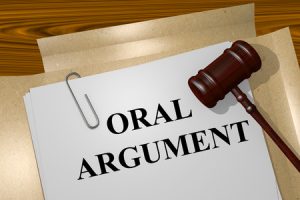 Ex parte appeals (or “appeals”) provide a rare opportunity for applicants to involve new decision-makers to independently assess the quality of pending rejections. However, a substantial disadvantage of appeals is that they introduce a sizable prosecution delay. The average delay between a time at which an appeal is received at the Patent and Trademark Appeal Board (PTAB) and issuance of a Decision is 26 months. This information comes from an E-mail from U.S. Patent & Trademark Office, to Kate Gaudry, Attorney, Kilpatrick Townsend & Stockton, LLP (Aug. 20, 2015) (on file with author).
Ex parte appeals (or “appeals”) provide a rare opportunity for applicants to involve new decision-makers to independently assess the quality of pending rejections. However, a substantial disadvantage of appeals is that they introduce a sizable prosecution delay. The average delay between a time at which an appeal is received at the Patent and Trademark Appeal Board (PTAB) and issuance of a Decision is 26 months. This information comes from an E-mail from U.S. Patent & Trademark Office, to Kate Gaudry, Attorney, Kilpatrick Townsend & Stockton, LLP (Aug. 20, 2015) (on file with author).
Not only does this delay affect a time at which a patent may issue, but it also may result in circumstance changes while the appeal is left pending (e.g., changes in case law or preferable argument strategies). Further, PTAB judges may lack the familiarity with an invention that an examiner may have gained through involvement of multiple rounds of prosecution, participation in one or more interviews and/or more detailed review of a specification.
One strategy to address these legitimate issues is to request an Oral Hearing. Any request for an Oral Hearing must be filed within two months from the date of the Examiner’s Answer to the Appeal Brief or on the date of filing a Reply Brief, whichever is earlier. 37 CFR 41.47(b). The request must be accompanied by a government fee, which is currently set to $1,300 for large entities. 37 CFR 41.20(b)(3). The PTAB will inform the appellant of a date for the Oral Hearing (unless the PTAB determines that a Hearing is not necessary, in which case, the appellant will be so informed). 37 CFR 41.47(d).
Ex Parte Appeal Oral Hearings are Rarely Conducted
To investigate the use and effect of the Hearings, we submitted a Freedom of Information Action (FOIA) request to the USPTO that requested data identifying appeals for which PTAB decision had been rendered since January 1, 2006. We further requested an indication as to whether an Oral Hearing had been conducted.
This data set shows that Oral Hearings are rarely conducted. (See Figure 1.) Across the 72,443 appeals, only 459 (0.63%) appeals had an Oral Hearing.

Oral Hearings are Conducted Shortly before Decision Issuance
The timing of when a Hearing is conducted may affect its usefulness. If Hearings were conducted shortly after an Examiner’s Answer was issued, Judges may forget about the issues raised when crafting a decision years later. The applicable regulation indicates that the PTAB will set a date for the Oral Hearing, but it does not specify when– within the multi-year appeal pendency – an Oral Hearing is to occur. While 37 CFR 41.47(d) indicates that a compliant request for an oral hearing will be assigned a hearing date, the MPEP does not indicate a timeframe for that for the hearing. Therefore, in our FOIA request, we further requested, for each Appeal, identification of the date of Appeal Brief filing, the date of Oral Hearing (if applicable), and the date of Decision issuance.
Figure 2 shows a timeline of these three events, which indicates the relative timing of the events. As shown, the Oral Hearing typically occurs after most of the appeal pendency and shortly before the Decision is issued. Specifically, the mean and median delay between the Oral Hearing and Decision is 1.7 and 0.87 months, respectively. Meanwhile, the mean and median delay between the Appeal-Brief filing and Oral Hearing were 17.6 and 14.8 months, respectively.

Figure 3 shows the distribution of the time between the Oral Hearing and Decision. A decision was issued within three weeks from an Oral Hearings for 43% of the appeals (and within four weeks for 53% of the appeals). Thus, most appellants who participated in Oral Hearings were afforded an opportunity to explain their reasoning to the new decision-makers very shortly before a decision was to be made.

Oral Hearings Provide an Opportunity to Address Recent Court and PTAB Decisions
At an Oral Hearing, an Appellant is “ordinarily” provided twenty minutes to present arguments. The examiner is also allowed to participate in an Oral Hearing, though anecdotal accounts indicate that examiners frequently decline this opportunity. These arguments are to correspond with points presented in an Appeal Brief or Reply Brief. However, an exception states that “upon a showing of good cause, appellant … may rely on a new argument based upon a recent relevant decision of either the Board or a Federal Court.” See 37 CFR 41.47(e)(2).
The timing data shown in Figures 1 and 2 and the exception indicate why Oral Hearings can be an exceedingly useful strategy. Many court and PTAB decisions issue within the multi-year pendency of an appeal. Each such decision may adjust an interpretation of a patent statute. An Appellant likely has limited to no means to predict such a changed interpretation, meaning that it would not be addressed in an Appeal Brief. Meanwhile, a PTAB Judge may then be required or may opt to follow the new interpretation. Without an Oral Hearing, an Appellant may be forced to either pull an appeal from the appeal cycle (by filing an RCE) or merely hope that the Board will happen to share an interpretation that the Appellant would favor.
A strong example of this predicament followed the issuance of Alice Corp. v. CLS Bank. 134 S. Ct. 2347 (2014). This decision changed how patent eligibility was to be evaluated, which was clearly relevant to pending appeals challenging an eligibility rejection. Beyond that, the decision even influenced pending appeals that did not have a pending eligibility rejection, as the Board itself issued new eligibility rejections against a number of applications. While an Oral Hearing would not provide amendment opportunities, it would have at least allowed stakeholders to address the new test.
Oral Hearings are Associated with More Reversals of Rejections
Finally, to investigate the empirical efficacy of Oral Hearings, we requested identification of the decision type for each appeal in our FOIA request. A decision type could be a full reversal of all rejections (e.g., a full win for the appellant), a full affirmance of all rejections (e.g., a full loss for the appellant), or a partial affirmance.
As shown in Figure 4, Oral Hearings were associated with more full-rejection reversals (blue bars). Specifically, the full reversals accounted for 40.3% of the appeals with Oral Hearings, as compared to 32.5% of the appeals without Oral Hearings. We recognize that a selection bias may influence the magnitude of this difference.

Conclusions
Appeals are a costly prosecution action, with large-entity fees totaling approximately $7,800 ($800 for the Notice of Appeal, $2,000 for the Forwarding Fee, and a median cost of $5,000 for attorney fees to prepare the Appeal Brief). See American Intellectual Property Law Association, Report of the Economic Survey I-93 (2015). However, an appeal may preserve valuable claim scope and/or “save” even more money by reducing the number of subsequently issued office actions. To achieve these advantages, an Appellant must ensure that the best arguments and reasoning have been presented to the PTAB. Oral Hearings not only avail oral advocacy but also allow appellants to ensure that arguments are current and address any recent decisions. The usage, timing and efficacy data indicates that Oral Hearings may be a valuable and under-recognized strategy for securing favorable appeal and prosecution outcomes.

![[IPWatchdog Logo]](https://ipwatchdog.com/wp-content/themes/IPWatchdog%20-%202023/assets/images/temp/logo-small@2x.png)


![[Advertisement]](https://ipwatchdog.com/wp-content/uploads/2024/04/Patent-Litigation-Masters-2024-sidebar-700x500-1.jpg)

![[Advertisement]](https://ipwatchdog.com/wp-content/uploads/2021/12/WEBINAR-336-x-280-px.png)
![[Advertisement]](https://ipwatchdog.com/wp-content/uploads/2021/12/2021-Patent-Practice-on-Demand-recorded-Feb-2021-336-x-280.jpg)
![[Advertisement]](https://ipwatchdog.com/wp-content/uploads/2021/12/Ad-4-The-Invent-Patent-System™.png)






Join the Discussion
One comment so far.
Paul F. Morgan
May 6, 2017 09:53 amThis reported very small present number of requested PTAB oral hearings in ex parte appeals seems surprisingly below historic rates.
It deprives one of the opportunity to display and explain enlarged graphics of evidence presented below. Of course if one is not also prepared to answer unexpected questions about the case and its technology, it will not help the case.
That preparation cost must also be considered.
Some patent attorneys have taken the view that if they lose an appeal they can file a continuation, but getting claims allowed by an examiner who has been sustained on appeal can be difficult.